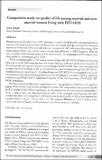| dc.description.abstract | Human immunodeficiency virus (HIV) infection is a serious health problem among married and non-married women. It has become a health problem for women of all ages. Antiretroviral therapies introduced in the mid 1990s have allowed many women with HIV infection to live long~ before progressing to AIDS, and to have longer survival time following an AIDS diagnosis. Then the issue of quality 0£.life becomes important for these women. The progression of HIV disease most often results in a decreasing quality of life.
While examining quality of life among women living with HIV/AIDS, limited attention has been paid to study addressing the issue of whether there is a difference in the levels of quality of life between married and non-married women living, with HIV/AIDS. This study will assess and compare the levels of quality of life in married and non-married women living with HIV/AIDS. Random systematic sampling of 114 women living with HIV/ AIDS who participated in the study were-administered well structured questionnaires by the palliative care nurses. Quality of life was evaluated using World Health Organization's Quality of Life HIV short form (WHOQOL HIV BREF) instrument.
The data reported in this study suggest that there is no significance difference with regard to quality of life between married and non-married women. The independent t test revealed that the levels of quality of life differed significantly in the married and the non-married respondents, t (112) = -2.64; p value =.01. But controlling the effect of the covariates in both groups, the result revealed that there was no significant difference in the levels of quality of life in non-married and married women, t (1J2) = -1.4, p value = .17. The apparent difference (t (112) = -2.64; p value =.01) in the levels of quality of life was found to be due to covariates variables. | en_US |

